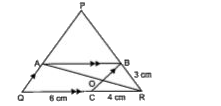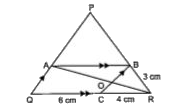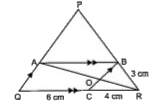Complete Solutions to Section C of chapter SPECIMEN QUESTION PAPER (MATHEMATICS) of Class 10 book with complete answers and questions
| Class 10 | MATHS |
| Chapter | SPECIMEN QUESTION PAPER (MATHEMATICS) |
| OSWAL GURUKUL | Section C |
| Number Of Questions | 12 |
| Academic Year | 2023-24 |
The distance between station A and B by road is 240 km and by train it is 300 km. A car starts from station A with a speed : km/hr whereas a train starts from station B with a speed 20 km/hr more than the speed of the car.
The time taken by car to reach station B is:
View SolutionThe distance between station A and B by road is 240 km and by train it is 300 km. A car starts from station A with a speed : km/hr whereas a train starts from station B with a speed 20 km/hr more than the speed of the car.
The time taken by car to reach station A is:
View SolutionThe distance between station A and B by road is 240 km and by train it is 300 km. A car starts from station A with a speed : km/hr whereas a train starts from station B with a speed 20 km/hr more than the speed of the car.
If the time taken by train is 1 hour less than that taken by the car, then the quadratic equation formed
View SolutionThe distance between station A and B by road is 240 km and by train it is 300 km. A car starts from station A with a speed : km/hr whereas a train starts from station B with a speed 20 km/hr more than the speed of the car.
The speed of the car is:
View SolutionIn the given triangle `PQR,AB||QR,OP||CB` and AR intersects CB at O.

Using the given diagram answer the following question:
The triangle similar to `DeltaARQ` is
View SolutionIn the given triangle `PQR,AB||QR,OP||CB` and AR intersects CB at O.

Using the given diagram answer the following question:
`DeltaPQR~DeltaBCR` by axiom :
View SolutionIn the given triangle `PQR,AB||QR,OP||CB` and AR intersects CB at O.

Using the given diagram answer the following question:
If QC = 6 Cm, CR=4 cm, BR =3 cm. The length of RP is:
View SolutionIn the given triangle `PQR,AB||QR,OP||CB` and AR intersects CB at O.

Using the given diagram answer the following question:
The ratio PQ:BC is:
View SolutionThe `n^(th)` term of an arithmetic progression (A.P.) is (3n + 1) :
The first three terms of this A. P. are:
View SolutionThe `n^(th)` term of an arithmetic progression (A.P.) is (3n + 1) :
The common difference of the A.P. is:
View SolutionThe `n^(th)` term of an arithmetic progression (A.P.) is (3n + 1) :
Which of the following is not a term of this A.P.?
View SolutionThe `n^(th)` term of an arithmetic progression (A.P.) is (3n + 1) :
Sum of the first 10 terms of this A.P. is:
View Solution
Section C questions and complete solutions for chapter SPECIMEN QUESTION PAPER (MATHEMATICS) of SELINA MATHS (ENGLISH) of Class 10